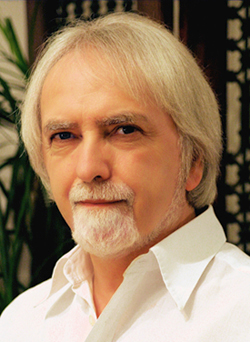 Bob Cywinski, or to give him his full title, Professor Robert Cywinski’s presentation, entitled “Particle Accelerators: From fundamental physics to cancer therapy” began with a brief history of particle accelerator technology, starting with the pioneering experiments of Rutherford and Cockcroft in the first quarter of the 20th century, leading to Lawrence’s development of the cyclotron, construction of the first synchrotron, and concluding with the massive 28km diameter high energy Large Hadron Collider at CERN.
Bob Cywinski, or to give him his full title, Professor Robert Cywinski’s presentation, entitled “Particle Accelerators: From fundamental physics to cancer therapy” began with a brief history of particle accelerator technology, starting with the pioneering experiments of Rutherford and Cockcroft in the first quarter of the 20th century, leading to Lawrence’s development of the cyclotron, construction of the first synchrotron, and concluding with the massive 28km diameter high energy Large Hadron Collider at CERN.
Although particle accelerators are usually associated with high energy physics, we learned that of the 15,000 accelerators currently in operation only about 100 are used in this field. The others find scientific, technological, medical and industrial uses that are essential to support our modern society. These uses are as diverse as sterilisation, surface modification for harder corrosion resistant materials, neutron and x-ray production for the study of matter at the atomic level, the production of radioisotopes for medical imaging, and even for the proton therapy treatment of cancers, particularly in sensitive regions of the body.
It is these latter medical uses that are now posing particular challenges for accelerator development. Bob described how physicists at the University of Huddersfield are developing a new type of compact, and therefore relatively cheaper, particle accelerator, the Fixed Field Alternating Gradient (FFAG) Accelerator to meet these new challenges. The team and their international collaborators have recently and successfully designed, built and commissioned EMMA, an £8M prototype FFAG, demonstrating that this new technology does actually work. The next stage is to secure funding for proton FFAGs. Small table top machines could be used in hospitals to provide radioisotopes for PET and SPECT imaging close to the patients, hence mitigating problems of transporting short-lived isotopes, while larger machines could provide high energy proton or carbon beams for cancer therapy.
Ultimately even more powerful FFAG accelerators could drive acceleration driven subcritical nuclear reactors for both the production of energy and the transmutation of radiotoxic nuclear waste and plutonium from conventional nuclear reactors.
It is clear that particle accelerators are going to play an increasingly important role in all of our lives.
A thoroughly enjoyable morning and Bob should be congratulated for giving us such an interesting and stimulating session.
We look forward yet another talk from Bob.
